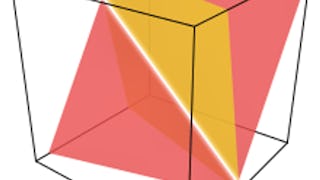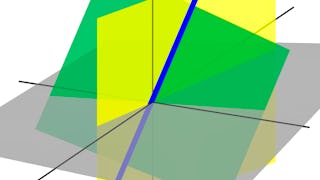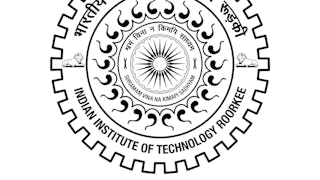This is the third and final course in the Linear Algebra Specialization that focuses on the theory and computations that arise from working with orthogonal vectors. This includes the study of orthogonal transformation, orthogonal bases, and orthogonal transformations. The course culminates in the theory of symmetric matrices, linking the algebraic properties with their corresponding geometric equivalences. These matrices arise more often in applications than any other class of matrices.


Linear Algebra: Orthogonality and Diagonalization

顶尖授课教师
2,991 人已注册
包含在 中
您将获得的技能
要了解的详细信息

添加到您的领英档案
11 项作业
了解顶级公司的员工如何掌握热门技能

积累特定领域的专业知识
- 向行业专家学习新概念
- 获得对主题或工具的基础理解
- 通过实践项目培养工作相关技能
- 获得可共享的职业证书

该课程共有4个模块
In this module, we define a new operation on vectors called the dot product. This operation is a function that returns a scalar related to the angle between the vectors, distance between vectors, and length of vectors. After working through the theory and examples, we hone in on both unit (length one) and orthogonal (perpendicular) vectors. These special vectors will be pivotal in our course as we start to define linear transformations and special matrices that use only these vectors.
涵盖的内容
2个视频2篇阅读材料3个作业
In this module we will study the special type of transformation called the orthogonal projection. We have already seen the formula for the orthogonal projection onto a line so now we generalize the formula to the case of projection onto any subspace W. The formula will require basis vectors that are both orthogonal and normalize and we show, using the Gram-Schmidt Process, how to meet these requirements given any non-empty basis.
涵盖的内容
3个视频3篇阅读材料4个作业
In this module we look to diagonalize symmetric matrices. The symmetry displayed in the matrix A turns out to force a beautiful relationship between the eigenspaces. The corresponding eigenspaces turn out to be mutually orthogonal. After normalizing, these orthogonal eigenvectors give a very special basis of R^n with extremely useful applications to data science, machine learning, and image processing. We introduce the notion of quadratic forms, special functions of degree two on vectors , which use symmetric matrices in their definition. Quadratic forms are then completely classified based on the properties of their eigenvalues.
涵盖的内容
2个视频2篇阅读材料3个作业
涵盖的内容
1个作业
获得职业证书
将此证书添加到您的 LinkedIn 个人资料、简历或履历中。在社交媒体和绩效考核中分享。
位教师

从 Machine Learning 浏览更多内容
 状态:免费试用
状态:免费试用Johns Hopkins University
 状态:免费试用
状态:免费试用Johns Hopkins University
 状态:免费试用
状态:免费试用Johns Hopkins University
 状态:预览
状态:预览IIT Roorkee
人们为什么选择 Coursera 来帮助自己实现职业发展




学生评论
43 条评论
- 5 stars
90.90%
- 4 stars
6.81%
- 3 stars
2.27%
- 2 stars
0%
- 1 star
0%
显示 3/43 个
已于 Nov 4, 2024审阅
It is great, the guy on the videos knows a lot, its a pity he writes so fast :))
已于 Dec 8, 2024审阅
Teach good. It explore some of my blind areas about diagonalization, eigen and orthogonal, repeated roots concern, etc.
已于 Mar 30, 2025审阅
Well taught, clearly explained, thorough and helpful examples throughout
常见问题
To access the course materials, assignments and to earn a Certificate, you will need to purchase the Certificate experience when you enroll in a course. You can try a Free Trial instead, or apply for Financial Aid. The course may offer 'Full Course, No Certificate' instead. This option lets you see all course materials, submit required assessments, and get a final grade. This also means that you will not be able to purchase a Certificate experience.
When you enroll in the course, you get access to all of the courses in the Specialization, and you earn a certificate when you complete the work. Your electronic Certificate will be added to your Accomplishments page - from there, you can print your Certificate or add it to your LinkedIn profile.
Yes. In select learning programs, you can apply for financial aid or a scholarship if you can’t afford the enrollment fee. If fin aid or scholarship is available for your learning program selection, you’ll find a link to apply on the description page.
更多问题
提供助学金,



